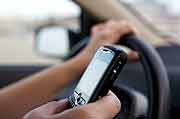
SUNDAY, April 29 (HealthDay News) — A pair of new studies offers insight into young people who use cellphones while driving: One finds that there’s no safe position for texting at the wheel, while the other suggests that the most compulsive cellphone users have had more car accidents.
The latter study “points to a link” between driving mishaps and young people who show symptoms similar to those of addiction when it comes to cellphone use, said lead author Jennifer Whitehill, a postdoctoral researcher at the University of Washington’s Harborview Injury Prevention and Research Center.
“We need to know if compulsive use of cellphones is predictive of the future” when it comes to accidents, Whitehill said. “If so, we may be able to identify these people and possibly counsel them.” The studies are slated for presentation Sunday at the annual meeting of the Pediatric Academic Societies, in Boston.
One study was conducted by Oklahoma high school students who are taking part in a community effort to stop teen drivers and families from texting on their cellphones while driving. The study sought to answer this question: Is there a safer way to position a cellphone in order to text while driving?
Thirty participants aged 15 to 19 used driving simulators in one of three ways: without a cellphone; while texting with the phone in a position that forced them to look downward to see messages; and while texting with the phone in a position of their choice.
The teen drivers were about four to six times more likely to drift out of their lanes in the simulation if they were texting, no matter where they put the phone. They were also twice as likely to have near misses with cars and pedestrians if they were texting, regardless of where the phone was.
In the other study, Whitehill and colleagues gave surveys to 384 undergraduate students that were designed to detect whether they were compulsive users of cellphones. Among other things, the questions asked whether they are emotionally attached to their cellphones, often anticipate calls or messages, and can’t function normally due to cellphone use.
The idea was to get at whether “you are thinking about your phone even when you’re not using, when it’s off,” she said.
The survey also asked about whether the participants had been in car accidents previously.
“The folks who scored higher on compulsive cellphone use had more prior crashes,” Whitehill said.
The study estimates that “if we had a group of 100 students with the lowest scores on the (compulsive scale), we would expect that 25 had a crash in the last year,” she said. “Among 100 students with the highest scores, we would see 38 crashes. That’s an extra 13 crashes per 100 students within the high-risk group.”
However, Whitehill said, the study doesn’t prove that compulsive cellphone use directly led to more accidents. It’s possible that another factor — such as being easily distracted — might account for both. “We didn’t ask about other types of anxious behaviors or general difficulties with being easily distracted,” she said.
Paul Atchley, an associate professor of psychology at the University of Kansas who studies driving and is familiar with Whitehill’s findings, said: “Studies like this are critical for traffic safety professionals trying to change this dangerous behavior. We need to understand the mind of our drivers to know how to help them change these dangerous behaviors.”
When it comes to preventing cellphone use while driving, adults should emphasize “the positive effects of staying off the phone while driving as opposed to the negative effects of being on it,” said Jessica Mirman, a behavioral researcher at the Center for Injury Research and Prevention at The Children’s Hospital of Philadelphia.
Because the studies were presented at a medical meeting, the data and conclusions should be viewed as preliminary until published in a peer-reviewed journal.
More information
To learn more about safe driving for teens, visit the U.S. National Library of Medicine.

